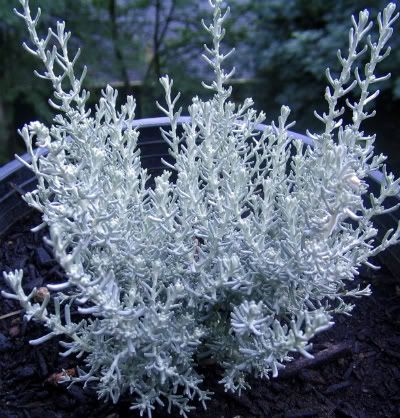
Do you recognize this plant? It's not aquatic and, while it resembles lavender, its distinctive scent will tell you that's not so. While on a plant expedition, Bob detected the unmistakable aroma of curry and followed the scent to these immature gray plants tucked in a corner of the nursery. He was intrigued and brought them home for me to investigate. Anyone who can boil water knows that curry is a blend of spices, so, I was taken aback when my nose picked up the curry-like scent that came from the plant. A quick bite revealed a taste similar to a blend of black tea and wild greens. The flavor was strong and didn't have much to commend it, but I wanted to learn more. I'd done some rudimentary research on the leaf of the curry tree and how it was used it Asian and Indian cooking. Taste alone told me this was not a curry leaf. I wanted to learn more about the curry plant and how it differed from the tree. Google to the rescue.
 The curry tree above is an aromatic shrub that can grow to 6 or 7 feet tall. Its leaves are glossy, aromatic and look like bay leaves. They have a mild citrus flavor and are used in curries in India, Bangladesh and Sri Lanka. The gray curry plant shown at the beginning of this entry has little, if any, culinary value. You can blend a very small amount of it with cream cheese or mayonnaise to make a passable spread but it's not a dip you'll dream about or yearn for. It real value lies in its essential oils and those do have some medicinal value. That doesn't do much for gardeners or cooks. That leaves us with that lovely fragrance that's released each time a branch is cut or bruised. If you love the aroma of curry, this plant's for you. Otherwise it's a classic case of caveat emptor.
The curry tree above is an aromatic shrub that can grow to 6 or 7 feet tall. Its leaves are glossy, aromatic and look like bay leaves. They have a mild citrus flavor and are used in curries in India, Bangladesh and Sri Lanka. The gray curry plant shown at the beginning of this entry has little, if any, culinary value. You can blend a very small amount of it with cream cheese or mayonnaise to make a passable spread but it's not a dip you'll dream about or yearn for. It real value lies in its essential oils and those do have some medicinal value. That doesn't do much for gardeners or cooks. That leaves us with that lovely fragrance that's released each time a branch is cut or bruised. If you love the aroma of curry, this plant's for you. Otherwise it's a classic case of caveat emptor.


No comments:
Post a Comment